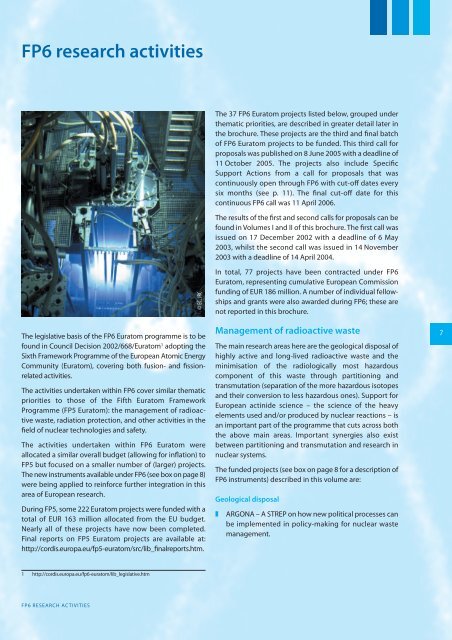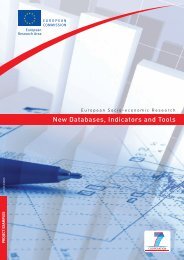Euratom FP6 Research Projects and Training Activities Volume III
Euratom FP6 Research Projects and Training Activities Volume III
Euratom FP6 Research Projects and Training Activities Volume III
Create successful ePaper yourself
Turn your PDF publications into a flip-book with our unique Google optimized e-Paper software.
<strong>FP6</strong> research activities<br />
The legislative basis of the <strong>FP6</strong> <strong>Euratom</strong> programme is to be<br />
found in Council Decision 2002/668/<strong>Euratom</strong> 1 adopting the<br />
Sixth Framework Programme of the European Atomic Energy<br />
Community (<strong>Euratom</strong>), covering both fusion- <strong>and</strong> fissionrelated<br />
activities.<br />
The activities undertaken within <strong>FP6</strong> cover similar thematic<br />
priorities to those of the Fifth <strong>Euratom</strong> Framework<br />
Programme (FP5 <strong>Euratom</strong>): the management of radioactive<br />
waste, radiation protection, <strong>and</strong> other activities in the<br />
field of nuclear technologies <strong>and</strong> safety.<br />
The activities undertaken within <strong>FP6</strong> <strong>Euratom</strong> were<br />
allocated a similar overall budget (allowing for inflation) to<br />
FP5 but focused on a smaller number of (larger) projects.<br />
The new instruments available under <strong>FP6</strong> (see box on page 8)<br />
were being applied to reinforce further integration in this<br />
area of European research.<br />
During FP5, some 222 <strong>Euratom</strong> projects were funded with a<br />
total of EUR 163 million allocated from the EU budget.<br />
Nearly all of these projects have now been completed.<br />
Final reports on FP5 <strong>Euratom</strong> projects are available at:<br />
http://cordis.europa.eu/fp5-euratom/src/lib_finalreports.htm.<br />
1 http://cordis.europa.eu/fp6-euratom/lib_legislative.htm<br />
<strong>FP6</strong> RESEARCH ACTIVITIES<br />
© EC, JRC<br />
The 37 <strong>FP6</strong> <strong>Euratom</strong> projects listed below, grouped under<br />
thematic priorities, are described in greater detail later in<br />
the brochure. These projects are the third <strong>and</strong> final batch<br />
of <strong>FP6</strong> <strong>Euratom</strong> projects to be funded. This third call for<br />
proposals was published on 8 June 2005 with a deadline of<br />
11 October 2005. The projects also include Specific<br />
Support Actions from a call for proposals that was<br />
continuously open through <strong>FP6</strong> with cut-off dates every<br />
six months (see p. 11). The final cut-off date for this<br />
continuous <strong>FP6</strong> call was 11 April 2006.<br />
The results of the first <strong>and</strong> second calls for proposals can be<br />
found in <strong>Volume</strong>s I <strong>and</strong> II of this brochure. The first call was<br />
issued on 17 December 2002 with a deadline of 6 May<br />
2003, whilst the second call was issued in 14 November<br />
2003 with a deadline of 14 April 2004.<br />
In total, 77 projects have been contracted under <strong>FP6</strong><br />
<strong>Euratom</strong>, representing cumulative European Commission<br />
funding of EUR 186 million. A number of individual fellowships<br />
<strong>and</strong> grants were also awarded during <strong>FP6</strong>; these are<br />
not reported in this brochure.<br />
Management of radioactive waste<br />
The main research areas here are the geological disposal of<br />
highly active <strong>and</strong> long-lived radioactive waste <strong>and</strong> the<br />
minimisation of the radiologically most hazardous<br />
component of this waste through partitioning <strong>and</strong><br />
transmutation (separation of the more hazardous isotopes<br />
<strong>and</strong> their conversion to less hazardous ones). Support for<br />
European actinide science – the science of the heavy<br />
elements used <strong>and</strong>/or produced by nuclear reactions – is<br />
an important part of the programme that cuts across both<br />
the above main areas. Important synergies also exist<br />
between partitioning <strong>and</strong> transmutation <strong>and</strong> research in<br />
nuclear systems.<br />
The funded projects (see box on page 8 for a description of<br />
<strong>FP6</strong> instruments) described in this volume are:<br />
Geological disposal<br />
❚ ARGONA – A STREP on how new political processes can<br />
be implemented in policy-making for nuclear waste<br />
management.<br />
7



